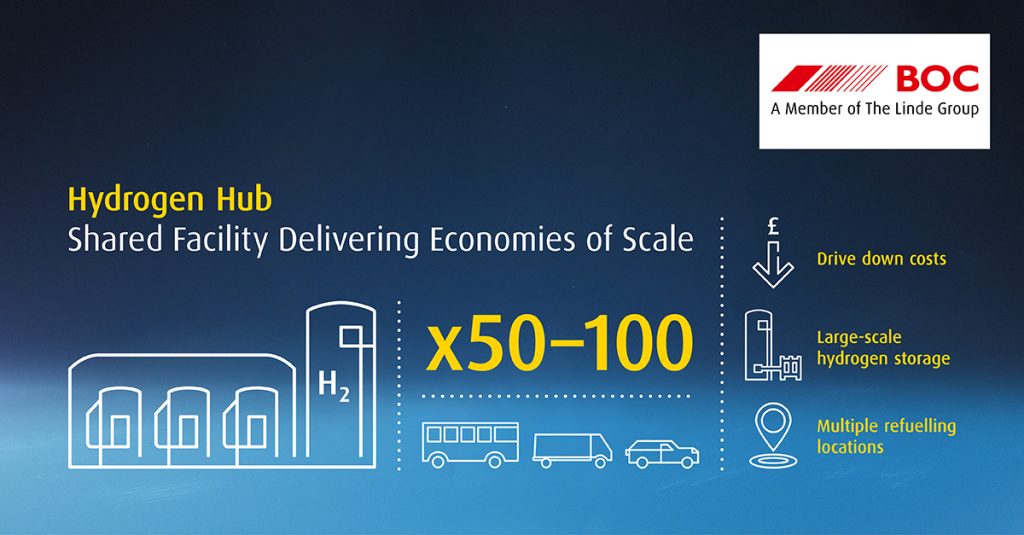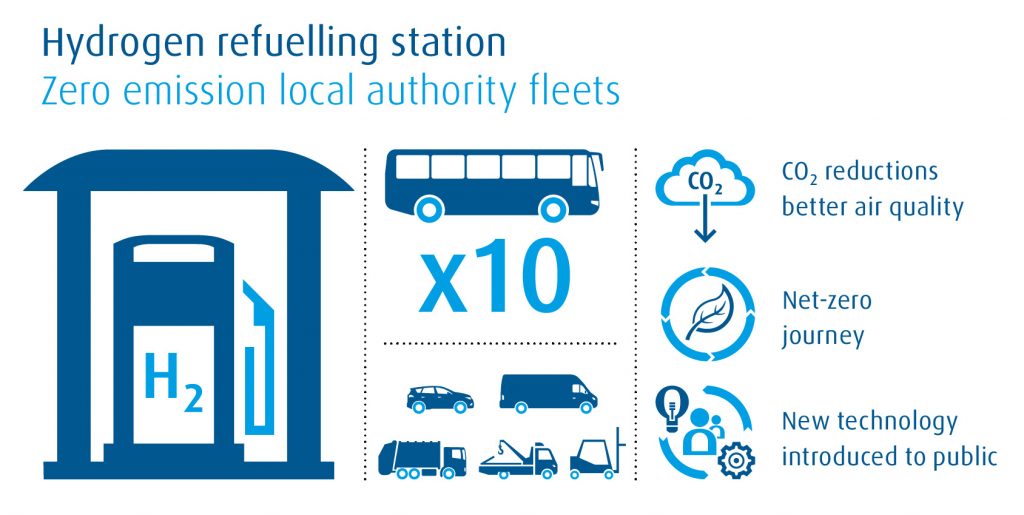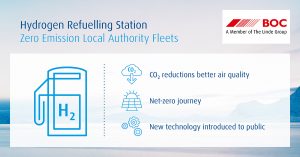By Chris Hampton, Product and Business Development Manager – Hydrogen, at BOC UK & Ireland

Council Guide to H2
Councils and local transport authorities (LTAs) are well-positioned to take a leading role in de-carbonising the UK’s transport system. By updating transport fleets to use zero emissions vehicles, councils can lead by example and, even more importantly, put the infrastructure in place to enable others to follow suit. Councils and LTAs should carefully consider their options for decarbonising transport. The decisions they make today could affect the choices available to other fleet operators tomorrow.
Where to start?
‘Where to start?’ is one of the most common questions asked by councils and LTAs. To answer that and more, we’ve compiled a simple guide, available here: BOC’s Guide to Decarbonising Transport with Hydrogen Hubs.
The hydrogen advantage
Hydrogen fuel cell vehicles offer some key advantages over battery electric vehicles. They offer a fast and familiar refuelling process, which is comparable to today’s petrol and diesel vehicles. Hydrogen vehicles also offer good range (typically 350-500km) from a single refuelling. A further benefit is that hydrogen suits big and heavy vehicles that would otherwise require heavy batteries to power them. These characteristics make hydrogen an ideal fuel for buses, refuse trucks, road sweepers, gritter lorries, delivery vans and other vehicles in daily use with the ability to return to base for refuelling. All of these vehicle types are running on hydrogen today.
From small to large scale
BOC offers modular refuelling stations that enable customers to start small and grow their infrastructure with increasing demand. If you operate a small fleet of vehicles but you want to benefit from the economies of scale that come with producing higher volumes of hydrogen, BOC can help you join forces with other users to build a shared refuelling facility with a larger vehicle usage. Scaling up can dramatically reduce the price of hydrogen.
Hydrogen is a strategic focus for the UK government and as a result there are a range of funding sources available to help finance your project. BOC is also able to help finance the capital cost for high-volume refuelling hubs.

Hydrogen Refuelling Station
Location
As well as having a location for vehicles to access dispensing pumps, a refuelling station will need space to store the hydrogen and an electrolyser to produce it. However, the area needed is typically no bigger than a traditional petrol forecourt. Layouts can be designed to fit almost any space and sites can be safely located adjacent to residential areas, if required.
Green hydrogen
To produce green hydrogen, you need renewable energy. BOC works with customers to source renewable power from a suitable supplier.
Safety
Hydrogen refuelling stations are safe. You must of course ensure appropriate safety distances from nearby assets, but this can be calculated and built into the engineering design. Hydrogen storage vessels are purpose built and designed to maintain pressures at optimal, safe levels and pumps are designed to ensure a safe connection between the dispenser and vehicle – with effective system safety checks every time hydrogen is dispensed. BOC has been producing hydrogen for over 100 years and it’s parent company, the Linde Group, has designed and installed over 200 hydrogen refuelling stations worldwide.
 Timescales
Timescales
Typical total build time is around 15-18 months. This allows for planning permission, civil engineering works, construction and commissioning.
Demonstrating success
When Aberdeen City Council wanted to develop a cleaner public transport network, it worked with BOC to develop, install and operate a tailored, state-of-the-art hydrogen refuelling station. The facility, based at the Kittybrewster bus depot, produces green hydrogen from electrolysis on site, and supplies a fleet of buses that travel up to 350km each day. Kittybrewster is now accessible to all hydrogen-fuelled vehicles, including double decker buses and private vehicles.
Moving forward
Opting for hydrogen refuelling to decarbonise your transport fleets is simpler than you think. By putting modular infrastructure in place it’s possible to scale up, share costs and help other fleet operators decarbonise their vehicles too. The first step is to find the right partner. A good hydrogen fuel specialist should be able to manage the whole project, from assessing specific transport and infrastructure needs to advising on funding, design and development of the facility. It could even operate and maintain it for you.
If you’d like to find out more you might find BOC’s guide to Decarbonising Transport with Hydrogen Hubs a useful resource. It contains all the information in this article – and more – in a handy PDF format.







Recent Comments